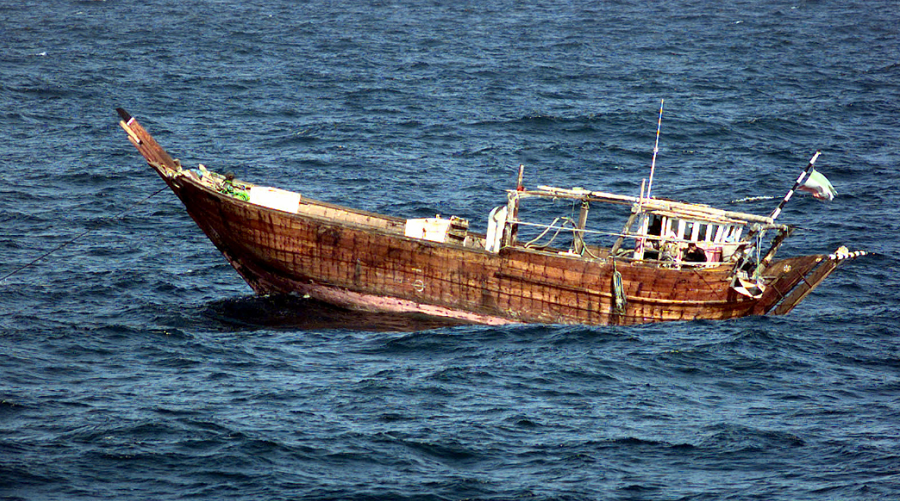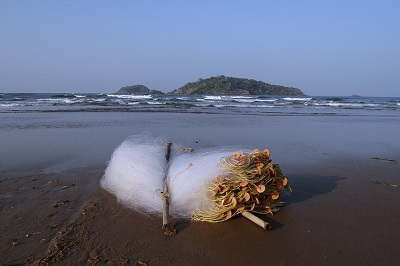
Iranian fishing boat in the Arabian Sea. Public Domain image from US National Archives.
Countries surrounding the Arabian Sea should empower well-managed artisanal and subsistence fisheries to back food security efforts, a new Sea Around Us study suggests.
In a chapter titled “The fisheries of the Arabian Sea Large Marine Ecosystem,” included in the book The Arabian Seas: Biodiversity, Environmental Challenges and Conservation Measures published by Springer Nature, Sea Around Us researchers describe the fisheries in the exclusive economic zones of Somalia, Djibouti, Yemen, Oman, the United Arab Emirates, Iran, Pakistan and India’s Malabar coast, as well as in the region’s high seas.
They point out how industrial operations are responsible for 44% of total catches in the 65-year period covered in the study (1950-2014), with most catches being taken from India’s, Pakistan’s and Yemen’s EEZs. Although the industrial sector’s catches grew steadily and peaked in 1997, from the early 2000s onwards, catches started declining and have stabilized at around 2.3 Mt per year.
The decline is attributed to excessive fishing aided by poor fisheries regulations and often lack of enforcement, which has meant that over the last 20+ years, an increasing number of stocks in the Arabian Sea LME have started to dwindle.
“We analyzed 298 fish stocks and, of those, over 50 per cent are in the fully exploited category with few – if any – with potential for fisheries growth,” said Deng Palomares, lead author of the chapter and the Sea Around Us project manager at the University of British Columbia’s Institute for the Oceans and Fisheries. “About 25 per cent, on the other hand, are overexploited and the trend that we see is one of increasingly more overexploited, collapsed and fully exploited stocks, while stock rebuilding seems to be poor.”
Palomares said that, over time, catches in this ecosystem have increasingly consisted of species lower in the food web, which means that larger fishes such as tunas are being fished out and smaller organisms are becoming more prevalent.

Fishing net on an Arabian Sea beach. Photo by Sarangib, Pixabay.
“This confirms the existence of ‘fishing down the food web’ in this area,” Palomares said.
The small-scale sector also plays an important role in the Arabian Sea Large Marine Ecosystem, with combined catches of artisanal and subsistence fisheries reaching approximately 2.1 Mt per year in the 2010s. The analysis shows that, throughout the studied period, 56 per cent of catches are taken by small-scale operators who either sell the fish on local markets and keep a small portion or keep the entire catch for their own and their families’ consumption.
“The high proportion of artisanal and subsistence fishers means that the majority of the fishing in this LME and thus the majority of catches occur within national EEZ waters,” said Dirk Zeller, coauthor of the study and director of the Sea Around Us – Indian Ocean at the University of Western Australia. “This means that national governments can manage the exploitation of marine resources, allowing for potentially better control compared to most fishing in the high seas waters.”
Even though some progressive actions have been taken already, such as the 2011 trawl ban in Oman and the ban on driftnets in the UAE in the late 1980s, in both countries, as elsewhere in the region, the lack of control based on a strong and well-defined legal framework means that most regulatory measures are ignored.
“Serious considerations ought to be given by all countries to policies that focus on reducing and tightly controlling industrial fishing, both domestic and foreign, and assisting well-managed small-scale fisheries for both national consumption and carefully controlled and monitored export fisheries,” Zeller said. “This is the direction in which all fisheries around the world need to be heading, to ensure the survival of a blue economy.”


